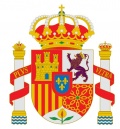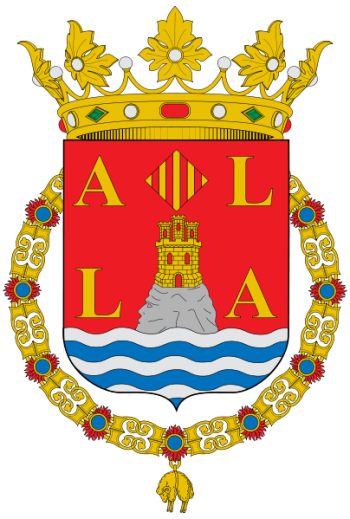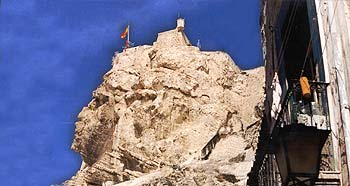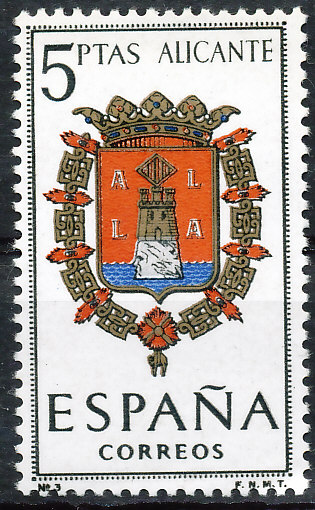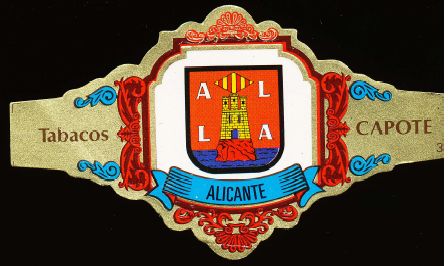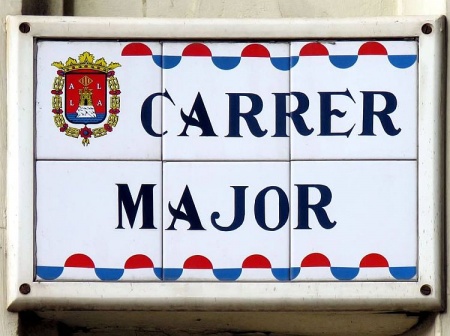Alicante: Difference between revisions
Knorrepoes (talk | contribs) m (Text replacement - ".png|center|Escudo de {{PAGENAME}}]]" to ".png|center|350 px|Escudo de {{PAGENAME}}]]") Tags: Mobile edit Mobile web edit |
Knorrepoes (talk | contribs) m (Text replacement - "{{media}} Literature :" to "Literature : {{media}}") |
||
| Line 36: | Line 36: | ||
|align="center"|[[File:alicante3.jpg|center|450 px]] <br/>The arms on a street sign (image Eduardo Panizo Gómez) | |align="center"|[[File:alicante3.jpg|center|450 px]] <br/>The arms on a street sign (image Eduardo Panizo Gómez) | ||
|} | |} | ||
[[Literature]] : | |||
{{media}} de Cadenas, A. A. and de Cadenas, V. : Heraldica de las comunidades autonomas y de las capitales de provincia. Hidalguia, Madrid, 1985; Louda, J. : European Civic Heraldry. Hamlyn, London, 1966; | |||
[[Category:Spanish Municipalities A]] | [[Category:Spanish Municipalities A]] | ||
[[Category:Alicante]] | [[Category:Alicante]] | ||
[[Category:Comunidad Valenciana]] | [[Category:Comunidad Valenciana]] | ||
Revision as of 06:19, 7 September 2022
Spanish heraldry portal
This page is part of the Spanish heraldry portal |
Heraldry of the World |
|
Civic heraldry:
|
Other heraldry: |
ALICANTE - ALACANT
Region : Comunidad Valenciana
Province : Alicante
| Spanish | En campo de gules,, sobre ondas de azur y plata, una peña de rostro humano, sumada de un castillo de oro, almenado, mazonado y aclarado de gules, sumado a su vez de un losange, de oro, con cuatro palos de gules, y acompañado a la diestra por las letras A y L (Acra Leuka), y a la siniestra L y A (Lucentum Alicante) de oro y puestas en palo. Rodea al escudo el toisón de oro. |
| English | No blazon/translation known. Please click here to send your (heraldic !) blazon or translation |
Origin/meaning
The town was liberated from the Moors in the 13th century by James I of Aragon. The arms show the arms of Valencia above a tower, symbolizing the fact that the city was a fortress in the Valencia region. The letters are the initials of the city during the centuries : A-L for Akra Leuka (during the Gree-Carthagean era), L for Lucentum (during the Roman era) and A for Alicante (since the Arabic times).
The rock (el Monte Benecantil) on which the castle (el castillo de Santa Bárbara) is standing on is in the shape of a human face. This is because the rock - a completely natural formation - does actually look like a human face if looked at from the sea; it is known as the Moor's Face, see below
| The rock in Alicante, from www.alicante.es |
The arms are surrounded by the Order of the Golden Fleece. This chain was deed by King Philip V in recognition of the support he received from the city against his opponent during the War of Spanish Succession.
| The arms on a stamp |
The arms on a cigar band |
| The arms on a street sign (image Eduardo Panizo Gómez) |
Contact and Support
Partners:
Your logo here ?
Contact us
© since 1995, Heraldry of the World, Ralf Hartemink 
Index of the site de Cadenas, A. A. and de Cadenas, V. : Heraldica de las comunidades autonomas y de las capitales de provincia. Hidalguia, Madrid, 1985; Louda, J. : European Civic Heraldry. Hamlyn, London, 1966;
